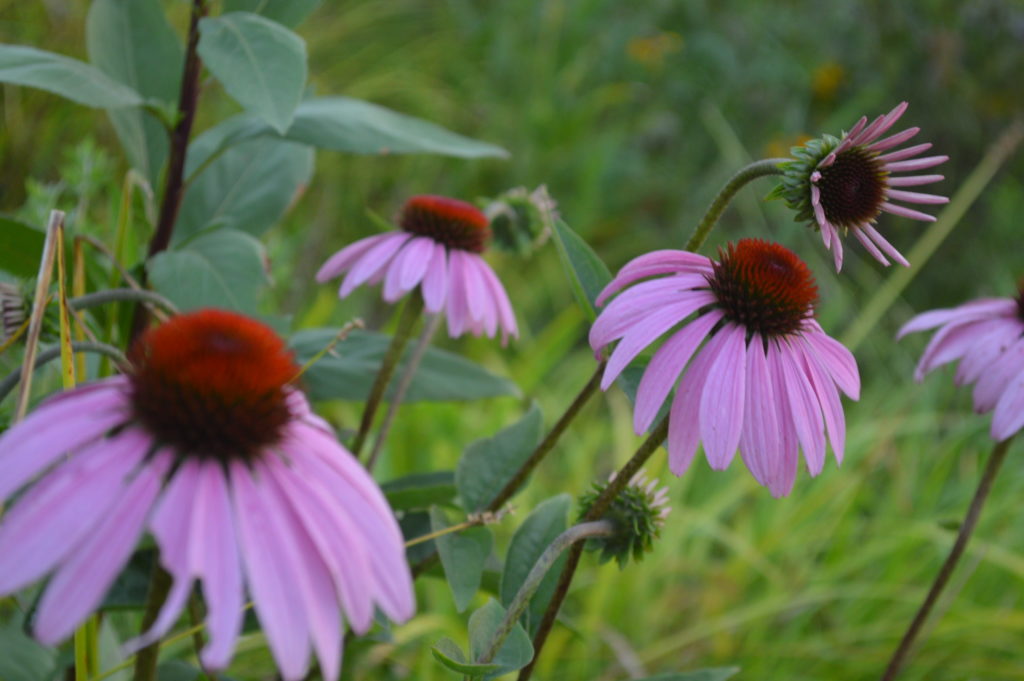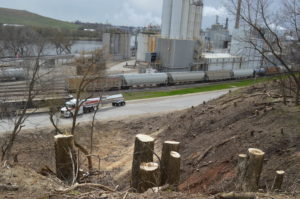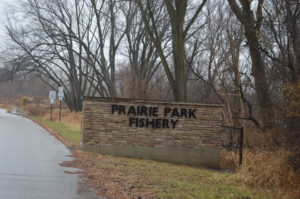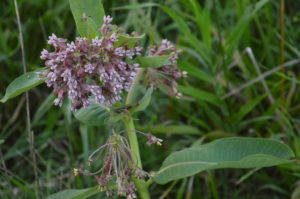
Purple coneflower grow in the Prairie Pollinator Zone on Stewart Road SE in 2020. The Cedar Rapids City Council voted in favor of measures related to Cargill’s plans to build an industrial railyard on the site. (photo/Cindy Hadish)
CEDAR RAPIDS, Iowa — The Cedar Rapids City Council dashed any remaining hopes that residents and nature lovers held to save a Prairie Pollinator Zone from destruction.
Council members unanimously passed a number of resolutions related to an agreement with multinational corporation Cargill to build a 200-car, 12-track railyard on a 28-acre property on Stewart Road SE during the council’s meeting on April 13, 2021.

Stumps are left behind as trees are cleared in April 2020, across from the Cargill plant in Cedar Rapids, Iowa. Cargill’s proposed railyard is nearly two miles away. (photo/Cindy Hadish)
More: See the list of resolutions related to the Cargill proposal
Though no public hearings were held related to Cargill, 10 people spoke out against the proposals during the virtual meeting via Zoom.
“It’s not too late to do the right thing,” said state Senator Rob Hogg, who lives along Otis Road SE, near Cargill’s proposed railyard.
Hogg noted that residents, cyclists, dog walkers and others who use the nature corridor will be exposed to 10,000 truckloads of dirt and rock that will begin rolling past the Indian Creek Nature Center to build the railyard.
The City Council began its meeting with a presentation on recreational opportunities on the Cedar River. Hogg added that the railyard, which will be built in a floodplain, will be detrimental to the very waters the city touted for recreation.
“Stop the destruction,” Hogg asked the council, citing the need for natural areas in the city, particularly after last year’s devastating hurricane-strength derecho. “If you can do this to our neighborhood, you can do this to every neighborhood.”

The Prairie Park Fishery, with trails used by hikers, walkers, bicyclists and bird watchers is next to the field where Cargill intends to build a railyard. (photo/Cindy Hadish)
Two members of the Cedar Rapids Sunrise movement, a climate justice group dedicated to fighting climate change and ending fossil fuel money influencing politics, spoke in support of residents of the nearby Rompot neighborhood, saying the City Council should stand up for its citizens, rather than corporate interests.
Other speakers cited the noise that will emanate from the railyard, which will operate 12 hours every day, 365 days per year; the environmental damage to air, land and water; loss of habitat and trees in the wake of the derecho windstorm and the imposition of an industrial site in a residential neighborhood, next to the Prairie Park Fishery.
Katie Hill, a self-proclaimed tree hugger, questioned why council member Dale Todd is advocating for Cedar Lake, but is “throwing the Prairie Park Fishery under the bus.”
“We can’t afford to lose any more trees or pollinator habitat,” she said.

Milkweed, the sole food source for monarch caterpillars, blooms in the Prairie Pollinator Zone in 2020. (photo/Cindy Hadish)
Kerry Sanders, who lives near the proposed railyard, noted that the Prairie Pollinator Zone was created for pollinators, including monarch butterflies, which will likely be granted status as an endangered species.
Allowing Cargill to build the railyard, with its history as an industrial polluter, is contrary to the support Cedar Rapids has long touted for monarch habitat, he said.
The site could also potentially be home to the rusty patched bumblebee, the first bee species in the United States to be placed on the endangered species list.
Barbary Stary, another nearby resident, called the prairie site “breathtaking” and noted it has become a popular spot for photos and selfies.
Cedar Rapids had received a state REAP grant to create the Prairie Pollinator Zone.
“The city may get around the agreement legally, but not morally,” Stary said.
Without comment, the City Council unanimously approved the resolutions, which were on the meeting’s consent agenda. Mayor Brad Hart said the resolutions were not “new actions,” but were related to items previously approved by the council.
Related: See photos of the Prairie Pollinator Zone from last summer.

A bee alights on a prairie coneflower in a zone created specifically for pollinators in Cedar Rapids, where an industrial railyard is planned. (photo/Cindy Hadish)

[…] More: City Council dashes last hope to save pollinator area […]